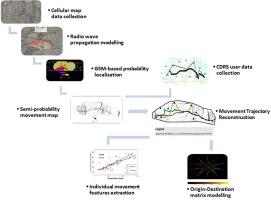Transportation Research Part C: Emerging Technologies ( IF 8.3 ) Pub Date : 2020-06-27 , DOI: 10.1016/j.trc.2020.102666 Mohammad Forghani , Farid Karimipour , Christophe Claramunt

|
The recent years have witnessed a greater demand for understanding how people move in urban environments. Due to the widespread usage of mobile phones, there have been several trajectory-based studies focusing on extracting the characteristics of human mobility from georeferenced mobile phone data. Mobile positioning data is generally generated as scattered points in CDRs (Call Detail Records). Even though CDR data can be regarded as an inexpensive scalable source of information on human mobility, mobility studies in urban settings based on such data sources still prove to be a research challenge due to the coarseness of CDR spatial granularity. Motivated by the need for transforming large-scale CDRs to movement trajectories, the present study offers a new solution which is made of two principal building blocks: (1) Developing a Bayesian-based induction method through adopting a GIS-based wave propagation model to solve the GSM-based localization problem when methods such as triangulation are not applicable due to the lack of measurements from more than one base station; (2) Reconstruction of movement trajectories from cellular location information using overlapping relations existing between observed cells as well as detection of ping-pong phenomena as auxiliary information. A case study employing CDR and GPS records obtained from an experimental survey on one of the central urban zones of Tehran was conducted, which showed the effectiveness of the proposed methodology in comparison to current approaches with respect to three perspectives, including movement path exploration, individual-oriented movement features extraction, and crowd-movement modelling.
中文翻译:

从蜂窝定位数据到轨迹:迈向更精确的移动性探索的步骤
近年来,见证人们对如何在城市环境中移动的需求越来越大。由于移动电话的广泛使用,已经有一些基于轨迹的研究专注于从地理参考的移动电话数据中提取人类移动性的特征。移动定位数据通常在CDR(呼叫详细记录)中作为分散点生成。尽管CDR数据可以被认为是有关人类流动性的廉价可扩展信息源,但由于CDR空间粒度的粗糙性,基于此类数据源的城市环境中的流动性研究仍被证明是一项研究挑战。由于需要将大型CDR转换为运动轨迹,因此本研究提供了一种新的解决方案,该解决方案由两个主要构造块组成:(1)当由于缺少多个基站的测量而无法使用三角测量等方法时,通过采用基于GIS的波传播模型来开发基于贝叶斯的归纳方法来解决基于GSM的定位问题;(2)使用观察到的细胞之间存在的重叠关系从细胞位置信息重建运动轨迹,以及检测乒乓现象作为辅助信息。进行了一个案例研究,该案例使用了从德黑兰市中心地区之一进行的实验调查获得的CDR和GPS记录,这表明与当前方法相比,从移动路径探索,个体角度三个方面来看,该方法相对于当前方法是有效的。面向运动的特征提取和人群运动建模。



























 京公网安备 11010802027423号
京公网安备 11010802027423号